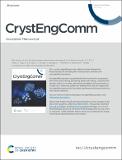Isoreticular chemistry of scandium analogues of the multicomponent metal-organic framework MIL-142
Abstract
Interpenetrated multicomponent MIL-142(Sc) MOFs were synthesised using the planar tritopic (4,4’,4’’-(1,3,5-triazine-2,4,6-triyl)tribenzoate, TATB, or 4,4’,4’’-(pyridine-2,4,6-triyl)tribenzoate, PTB)) and linear ditopic (1,4-benzenedicarboxylate, BDC, or 2-amino or 2-nitro-1,4-benzenedicarboxylate (NH2- or NO2-BDC) linkers. Structure solution of the MIL-142(Sc)-TATB series from single crystal X-ray diffraction in space group R3 ̅m reveals regioselective ordering of bulky NO2 groups in MIL-142(Sc)-TATB-NO2. Use of 1,3,5-benzenetribenzoate (BTB) favours instead the mesoporous Sc-BTB, the PTB analogue of which forms in the absence of BDC. The materials are highly porous: MIL-142(Sc)-TATB-BDC has a pore volume of 0.70 cm3 g-1.
Citation
Prasad , R R R , Pleass , C , Rigg , A , Cordes , D B , Lozinska , M M , Georgieva , V M , Hoffmann , F , Slawin , A M Z & Wright , P A 2020 , ' Isoreticular chemistry of scandium analogues of the multicomponent metal-organic framework MIL-142 ' , CrystEngComm . https://doi.org/10.1039/D0CE01593H
Publication
CrystEngComm
Status
Peer reviewed
ISSN
1466-8033Type
Journal article
Description
RRRP and PAW thank the Engineering and Physical Sciences Research Council (EPSRC) and CRITICAT Centre for Doctoral Training for Financial Support [PhD studentship to RRRP; EP/L016419/1]. MML and PAW would also like to thank EPSRC for FLEXICCS grant (Versatile Adsorption Process for the Capture of Carbon Dioxide from Industrial Sources; EP/N024613/1). The research data supporting this publication can be accessed at: https://doi.org/10.17630/536b5f75-ce3c-414b-a336-497e00280158.56Collections
Items in the St Andrews Research Repository are protected by copyright, with all rights reserved, unless otherwise indicated.

